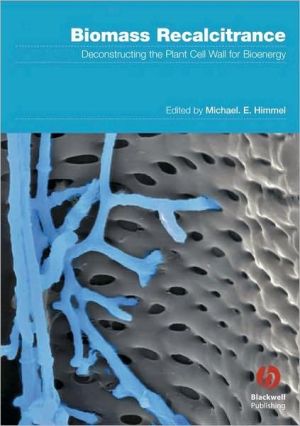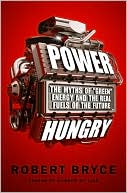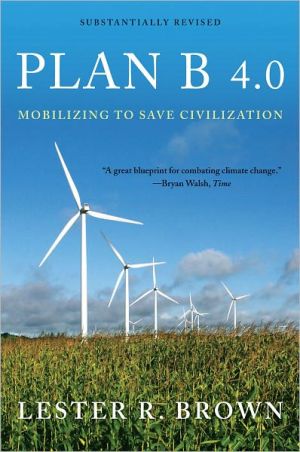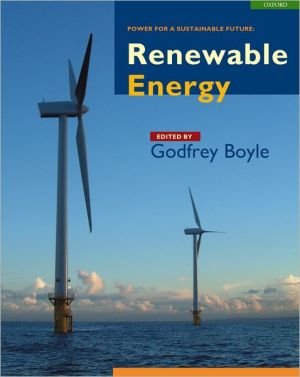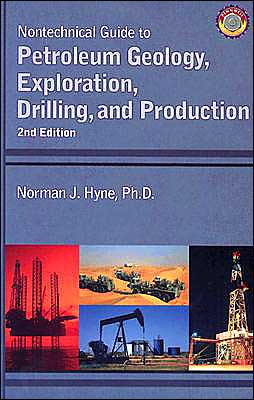Biomass Recalcitrance: Deconstructing the Plant Cell Wall for Bioenergy
Alternative and renewable fuels derived from lignocellulosic biomass offer a promising alternative to conventional energy sources, and provide energy security, economic growth, and environmental benefits. However, plant cell walls naturally resist decomposition from microbes and enzymes - this collective resistance is known as "biomass recalcitrance". Breakthrough technologies are needed to overcome barriers to developing cost-effective processes for converting biomass to fuels and...
Search in google:
Alternative and renewable fuels derived from lignocellulosic biomass offer a promising alternative to conventional energy sources, and provide energy security, economic growth, and environmental benefits. However, plant cell walls naturally resist decomposition from microbes and enzymes - this collective resistance is known as "biomass recalcitrance". Breakthrough technologies are needed to overcome barriers to developing cost-effective processes for converting biomass to fuels and chemicals. This book examines the connection between biomass structure, ultrastructure, and composition, to resistance to enzymatic deconstruction, with the aim of discovering new cost-effective technologies for biorefineries. It contains chapters on topics extending from the highest levels of biorefinery design and biomass life-cycle analysis, to detailed aspects of plant cell wall structure, chemical treatments, enzymatic hydrolysis, and product fermentation options. Biomass Recalcitrance is essential reading for researchers, process chemists and engineers working in biomass conversion, also plant scientists working in cell wall biology and plant biotechnology.
Preface xivAcknowledgments xvContributors xviOur Challenge Is to Acquire Deeper Understanding of Biomass Recalcitrance and Conversion Michael E. Himmel Stephen K. Picataggio 1The modern lignocellulose biorefinery 1Biomass recalcitrance to deconstruction 1Plants evolved to resist microbial and enzymatic assault! 2Are biomass-degrading enzymes working maximally? 2Chemical pretreatments are still required to reveal cell wall cellulose 3Fermenting cell wall sugars: the stage is set for systems/synthetic biology 4References 5The Biorefinery Thomas D. Foust Kelly N. Ibsen David C. Dayton J. Richard Hess Kevin E. Kenney 7Introduction 7Phase III - lignocellulosic biorefineries 10Feedstocks 12Biochemical conversion 17Thermochemical biorefinery 23Introduction 23R&D needs to achieve economic viability 26Advanced biorefinery 28Advanced, large-tonnage feedstock supply systems 28Systems biology to improvebiochemical processing 30Selective thermal transformation to improve thermochemical processing 32Technology integration, economies of scale, and evolutionary process optimization 34References 35Anatomy and Ultrastructure of Maize Cell Walls: An Example of Energy Plants Shi-You Ding Michael E. Himmel 38Introduction 38Cell wall anatomy 38Plant tissues 39Cell wall biosynthesis and molecular structure 41Biosynthesis 42Cell wall lamellae 45The macrofibril and elementary fibril 46The microfibril 47Cellulose 48Matrix polymers 49Advanced approaches for characterizing cell wall structure 49Atomic force microscopy 49Biophotonics and nonlinear microscopy 50Single molecule methods 50Computer simulations 51Summary 53Acknowledgment 55References 55Chemistry and Molecular Organization of Plant Cell Walls Philip J. Harris Bruce A. Stone 61Introduction 61Chemistry of cell wall polymers 62Chemistry of cell wall polysaccharides 62Chemistry of cell wall proteins 70Molecular associations between wall polymers 70Non-covalent interactions between wall polymers 70Covalent interactions between wall polymers 71Covalent cross-linking between wall polymers prevents polysaccharide utilization 78Molecular architecture of plant cell walls 79Primary cell walls 79Lignified secondary walls 81Degradabilities of the walls of different cell types by enzymes 83References 85Cell Wall Polysaccharide Synthesis Debra Mohnen Maor Bar-Peled Chris Somerville 94Introduction 94Cellulose 96Enzymology 98Cellulose deposition 100Regulation of cellulose synthesis 101Hemicellulose 104Mannan 104Xyloglucan 105Xylan 108Mixed linkage glucans 110Pectins 110Location of pectin synthesis 114Pectin biosynthetic glycosyltransferases 115Methyltransferases 119Acetyltransferases 119Other pectin modifying enzymes 119Homogalacturonan synthesis 120Xylogalacturonan synthesis 127Apiogalacturonan synthesis 127Synthesis of rhamnogalacturonan II (RG-II) 128Rhamnogalacturonan I (RG-I) synthesis 130The cell biology and compartmentalization of cell wall synthesis 136Nucleotide sugars 137Fermentation and nucleotide-sugars: a long history 140Fermentation and nucleotide-sugars: a long history 140Sugar kinase - pyrophosphorylase pathway to synthesize NDP-sugars 140Direct production of NDP-sugars 140NDP-sugar Interconversion Pathway 140SLOPPY, a general UDP-sugar pyrophosphorylase 142UDP-[alpha]-D-glucose (UDP-Glc) 143ADP-[alpha]-D-glucose (ADP-Glc) 145UDP-[alpha]-D-galactose (UDP-Gal) 146UDP-L-rhamnose (UDP-Rha) 147UDP-[alpha]-D-glucuronic acid (UDP-GlcA) 147UDP-[alpha]-D-galacturonic acid (UDP-GalA) 150UDP-[alpha]-D-xylose (UDP-Xyl) 151UDP-D-apiose (UDP-Api) 151UDP-L-arabinose pyranose (UDP-Ara) 152UDP-arabinose furanose (UDP-Araf) 153GDP-[alpha]-D-mannose (GDP-Man) 153GDP-[beta]-L-fucose (GDP-Fuc) 154GDP-[beta]-L-galactose (GDP-Gal), GDP-[beta]-L-gluclose gulose (GDP-Gul) 154CMP-[beta]-KDO (CMP-KDO) 154Other enzymes involved in NDP-sugar metabolism 155Future questions and directions 156Perspectives 159Acknowledgments 159References 159Structures of Plant Cell Wall Celluloses Rajai H. Atalla John W. Brady James F. Matthews Shi-You Ding Michael E. Himmel 188Introduction 188Background 189Cellulose microfibrils 190Molecular modeling 194Raman spectra 200Alternative patterns of aggregation 203Alternative approaches to the problem of crystallinity 210References 210Lignins: A Twenty-First Century Challenge Laurence B. Davin Ann M. Patten Michael Jourdes Norman G. Lewis 213Lignin: molecular basis and role in plant adaptation to land 213Lignin pathway evolution, deposition, and function in vascular anatomical development 218Vascular plant diversification and lignification 218Heartwood and reaction (compression/tension) wood tissues 223Pioneers of monolignol biosynthesis, recent progress, and metabolic flux analyses 225Phenylalanine formation 226Metabolic flux analyses and transcriptional profiling in the monolignol pathway 227Phenylalanine and tyrosine ammonia lyases 227Cytochrome P-450s and hydroxycinnamoyl CoA:shikimate/quinate hydroxycinnamoyl transferases 2284-Coumarate CoA ligases 229Cinnamoyl CoA reductases and cinnamyl alcohol dehydrogenases 230COMTs and CCOMTs 230Proteins of unknown physiological/biochemical functions in monolignol metabolism, "CAD1" and "sinapyl alcohol dehydrogenase, SAD" 232Recent developments: metabolic networks in the monolignol/lignin forming pathway (Arabidopsis) and (current) database annotations/limitations - opportunities and challenges 234Inherent shortcomings in lignin analyses: a critical juncture and the urgent need 235Lignin isolation procedures 236Lignin subunit and lignin structural analyses by NMR spectroscopy 237Quantification of lignin amounts, lignin degradation protocols, and synthetic dehydropolymerizates 239Modulation of monolignol pathway and peroxidase enzymatic steps: predictable effects on the vascular apparatus and on limited substrate degeneracy during proposed lignin template polymerization 242PAL, C4H, pC3H, HCT, and 4CL downregulation/mutation 243CCR, CAD, F5H, and COMT downregulation/mutation, and the enigma of monolignol radical generation 254Transcriptional control over secondary wall fiber formation: ramifications for lignification and vascular integrity 268Native lignin macromolecular configuration 268Early beginnings: the Freudenberg (random coupling) and the Forss (regular repeating unit) models for lignins 269Further refinement of structural depictions of lignins (1970s to the present date): a reassessment 272A new beginning: the need to fully define native lignin macromolecular configuration proper 274Future outlook: remaining questions in lignin macromolecular assembly/configuration, proposed lignin template replication, and overall cell wall formation 285Acknowledgments 287References 287Computational Approaches to Study Cellulose Hydrolysis Michael F. Crowley Ross C. Walker 306Introduction 306Molecular mechanics 307The force field equation 307Interatomic potentials 308Non-bonded cutoffs and long range electrostatics 311Molecular model types 312Force fields 313Carbohydrate force fields 314Solvent models 314Molecular dynamics 315Dynamics methods 316Finite difference methods 316System size limitations 316Quantum mechanics/molecular dynamics 317Analysis methods 317Enhanced sampling and free energy methods 319Free energy methods 320Studying cellulose hydrolysis 322Work to date 322Approaches to current questions about structure and hydrolysis 323Performance and future of cellulose modeling 324Current performance 324Future possibilities 325Acknowledgments 326References 326Mechanisms of Xylose and Xylo-oligomer Degradation During Acid Pretreatment Xianghong Qian Mark R. Nimlos 331Background 331Computational techniques 333Molecular dynamics simulations 333Static electronic structure theory 334Xylose degradation reactions in vacuum 335Effects of solvent water molecules 339Xylobiose calculations 340Experimental investigation of hydrolysis 344The hydrolysis of xylobiose 345The hydrolysis of xylan 346Corn stover 347Conclusions 348Future studies 349Acknowledgment 349References 349Enzymatic Depolymerization of Plant Cell Wall Hemicelluloses Stephen R. Decker Matti Siika-aho Liisa Viikari 352Introduction 352Hemicellulase types, activities, and specificities 355Depolymerases 359Xylanases 359Mannanases 360[beta]-glucanases 361Xyloglucanases 362Debranching enzymes (accessory enzymes) 362[alpha]-glucuronidase 363[alpha]-arabinofuranosidase 363[alpha]-D-galactosidase 363Acetyl xylan esterase 363Ferulic acid esterase 364Hemicellulase activities for biomass feedstocks 364Xylan 365Galactoglucomannan and glucomannan 366Arabinogalactan, xyloglucan, and [beta]-glucan 367Hydrolysis of solubilized hemicellulose 367Acknowledgment 368References 368Aerobic Microbial Cellulase Systems David B. Wilson 374Introduction 374Understanding cellulases 375Diversity of cellulases 376Cellulose-binding domains 379Cellulase synergism 380Cellulases from Trichoderma reesei 380Other fungal cellulases 381Cellulolytic aerobic bacteria 382Outlook 386References 386Cellulase Systems of Anaerobic Microorganisms from the Rumen and Large Intestine Harry J. Flint 393Introduction 393Cellulolytic and hemicellulolytic bacteria from the rumen 394Ruminococcus flavefaciens 394Other Clostridium-related anaerobic bacteria 396Plant cell wall breakdown by eukaryotic microorganisms 398Rumen fungi 398Rumen protozoa 398Information from metagenomics 399The large intestine 400Conclusions 400Acknowledgment 401References 401The Cellulosome: A Natural Bacterial Strategy to Combat Biomass Recalcitrance Edward A. Bayer Bernard Henrissat Raphael Lamed 407Introduction 407The cellulosome concept 408Cellulosomal carbohydrate-active enzymes 410The cellulosome-cellulose interaction 415Cell-surface disposition of cellulosomes 417Cellulosome assault on recalcitrant cellulose substrates 418Degradation of cellulose by the C. thermocellum cellulosome 420The cellulosome rationale 423Acknowledgments 426References 426Pretreatments for Enhanced Digestibility of Feedstocks David K. Johnson Richard T. Elander 436Introduction 436Enzyme usage and enzyme-type considerations for pretreated biomass 437Desired properties of pretreatment processes 437Physicochemical properties of pretreated biomass believed to affect cellulose digestibility 438Pretreatment approaches 439Physical pretreatments 440Rapid decompression pretreatments 440Autohydrolysis pretreatments 442Acidic pretreatments 443Alkaline pretreatments 444Solvent pretreatments 445Supercritical fluid pretreatments 446Oxidative pretreatments 446Biological pretreatment 447Future prospects 447Acknowledgment 449References 449Understanding the Biomass Decay Community William S. Adney Daniel van der Lelie Alison M. Berry Michael E. Himmel 454Introduction 454Defining biomass decay communities 456Fungi identified with plant biomass 457Bacteria identified with plant biomass 459Interactions between saprophytic fungi and bacteria 463Characterization of microbial communities that degrade biomass 464Biochemical approaches to define biomass degrading communities 465Molecular approaches for defining biomass-degrading communities 466Microarray methods suitable for biomass sampling 470Conclusions 472Acknowledgment 472References 473New Generation Biomass Conversion: Consolidated Bioprocessing Y.-H. Percival Zhang Lee R. Lynd 480Introduction 480Consolidated bioprocessing 481CBP advances 483Native cellulolytic microorganisms 483Recombinant cellulolytic strategy 488Future directions 489Acknowledgment 490References 490Index 495
\ From the Publisher"Biomass Recalcitrance is a must-have.... The compilation covers fundamentals as well as hot topics that will provide new insights and knowledge to many readers." (ChemSusChem, June 2009)\ \ \
